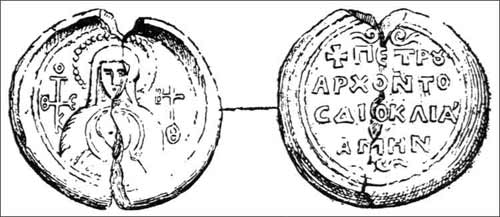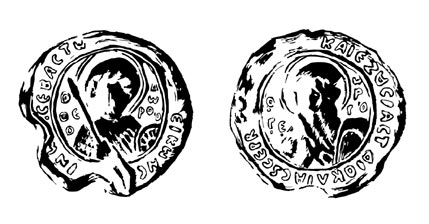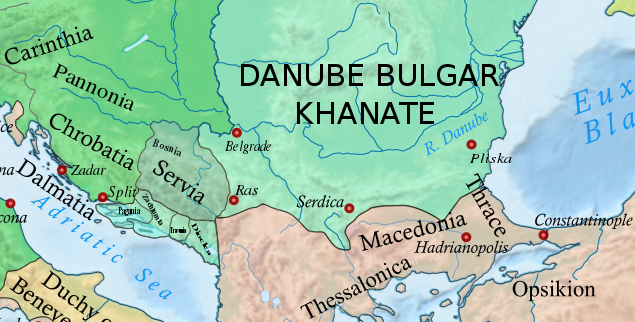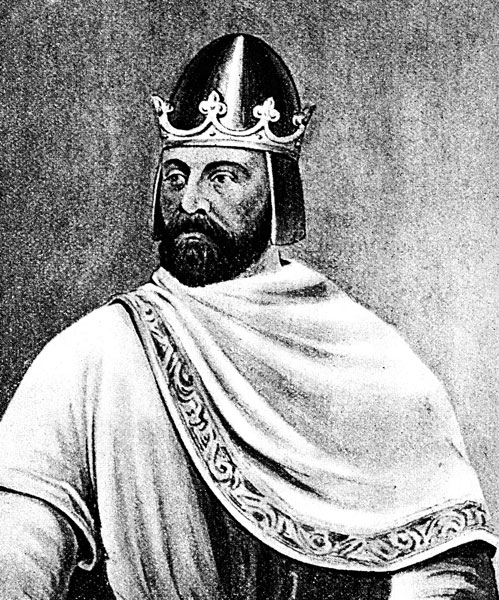|
List Of Rulers Of Duklja
This is a list of rulers of Duklja. List of rulers Duklja continues as a crownland of Grand Principality of Serbia, under Vukan Nemanjić and Đorđe Nemanjić. Rulers according to the Chronicle of the Priest of Duklja The following rulers are mentioned only in the Chronicle of the Priest of Duklja (CPD), written by a Catholic monk of the Cistercian order by the name of Roger (Rudger) at the request of Croatian Ban Paul Šubić. It was written in two versions – the first one in Split in 1298 while Roger was handling the Archbishop of Split's finances, and the second ca. 1300, while he was the Archbishop of Antivari (Bar). The chronicle, built round a core written in Slavonic, but added to by a bishop of Bar intent on demonstrating his diocese' superiority over that of Split, is one of the oldest known written sources, but only Latin redactions from the 16th and 17th centuries have been preserved. Historians have largely discounted it, though it contains material on the ea ... [...More Info...] [...Related Items...] OR: [Wikipedia] [Google] [Baidu] |
Duklja
Duklja ( sh-Cyrl, Дукља; el, Διόκλεια, Diokleia; la, Dioclea) was a medieval South Slavic state which roughly encompassed the territories of modern-day southeastern Montenegro, from the Bay of Kotor in the west to the Bojana River in the east, and to the sources of the Zeta and Morača rivers in the north. First mentioned in 10th– and 11th century Byzantine chronicles, it was a vassal of the Bulgarian Empire between 997 and 1018, and then of the Byzantine Empire until it became independent in 1040 under Stefan Vojislav ( 1034–43) who rose up and managed to take over territories of the earlier Serbian Principality, founding the Vojislavljević dynasty. Between 1043 and 1080, under Mihailo Vojislavljević ( 1050–81), and his son, Constantine Bodin ( 1081–1101), Duklja saw its apogee. Mihailo was given the nominal title ''King of Slavs'' by the Pope after having left the Byzantine camp and supported an uprising in the Balkans, in which his son Bodin playe ... [...More Info...] [...Related Items...] OR: [Wikipedia] [Google] [Baidu] |
Stefan Vojislav
Stefan Vojislav ( sr-cyr, Стефан Војислав; gr, Στέφανος Βοϊσθλάβος; 1034–d. 1043) was the Prince of Duklja from 1040 to 1043. Beginning in the year 1018, he served as a Byzantine governor, until 1034 when he led an unsuccessful revolt that landed him in a prison at Constantinople. He managed to escape and returned home, this time successfully gaining the independence of his statelet and expanding his rule over southern Dalmatia and its hinterland. He is the eponymous founder of the Vojislavljević dynasty. Origin and early life The contemporary Byzantine writers call him either a Serb or a Dukljan (''Βοϊσθλάβος ὁ Διοκλητιανός)'', but do not mention his genealogy, while the ''Chronicle of the Priest of Duklja'', a posterior, more dubious source, calls him a cousin to previous ruler Jovan Vladimir (r. 990–1016).Živković 2006, "Стефан Војислав". Having reached its pinnacle during the long reign of emperor ... [...More Info...] [...Related Items...] OR: [Wikipedia] [Google] [Baidu] |
Constantine Bodin
Constantine Bodin (Bulgarian and sr, italic=no, Константин Бодин, ''Konstantin Bodin''; 1072–1101) was a medieval king and the ruler of Duklja, the most powerful Serbian principality of the time, from 1081 to 1101, succeeding his father, Mihailo Vojislavljević ( 1046–1081). Born in peaceful times, when the Southern Slavs were subjects of the Byzantine Empire, his father was in 1072 approached by Bulgarian nobility, who sought aid in their revolt against the Byzantines; Mihailo sent them Bodin, who was crowned Bulgarian tsar under the name Petar III ( bg, Петър ІІІ, ''Petŭr III'') joined the short-lived revolt, being captured the following year after initial success. He was freed in 1078, and upon the death of his father in 1081 he succeeded to the throne of Dioclea. Having renewed his acknowledgement of Byzantine overlordship, he soon sided with their enemies, the Normans, which resulted in a Byzantine invasion and his capture. Although he quic ... [...More Info...] [...Related Items...] OR: [Wikipedia] [Google] [Baidu] |
Konstantin Bodin
Constantine Bodin (Bulgarian and sr, italic=no, Константин Бодин, ''Konstantin Bodin''; 1072–1101) was a medieval king and the ruler of Duklja, the most powerful Serbian principality of the time, from 1081 to 1101, succeeding his father, Mihailo Vojislavljević ( 1046–1081). Born in peaceful times, when the Southern Slavs were subjects of the Byzantine Empire, his father was in 1072 approached by Bulgarian nobility, who sought aid in their revolt against the Byzantines; Mihailo sent them Bodin, who was crowned Bulgarian tsar under the name Petar III ( bg, Петър ІІІ, ''Petŭr III'') joined the short-lived revolt, being captured the following year after initial success. He was freed in 1078, and upon the death of his father in 1081 he succeeded to the throne of Dioclea. Having renewed his acknowledgement of Byzantine overlordship, he soon sided with their enemies, the Normans, which resulted in a Byzantine invasion and his capture. Although he quic ... [...More Info...] [...Related Items...] OR: [Wikipedia] [Google] [Baidu] |
Mihailo I Of Duklja
Mihailo Vojislavljević ( sr-cyr, Михаило Војислављевић) was a medieval Serbian king and the ruler of Dioclea (Duklja), from 1046 to 1081 initially as a Byzantine vassal holding the title of ''protospatharios'', then after 1077 as nominally serving Pope Gregory VII, addressed as "King of the Slavs". He had alienated himself from the Byzantines when he supported a Bulgarian Uprising of Georgi Voyteh, after which he then sought to gain support in the West. In 1077 he received a royal insignia by Gregory VII in the aftermath of the Church schism of 1054. Life Early rule With the death of Stefan Vojislav, his dominion was divided among his five sons (according to CPD). Gojislav received Travunia (Trebinje) ruled briefly until he was killed by local nobles, who set up Domanek in his place. Mihailo expelled him and Saganek chosen to rule, but Domanek returned and drove him out. Mihailo offered the office to Radoslav, who declined, afraid of losing Luška župa ( ... [...More Info...] [...Related Items...] OR: [Wikipedia] [Google] [Baidu] |
Srpski Kralj Mihajlo Lik 140x190
Serbian (, ) is the standardized variety of the Serbo-Croatian language mainly used by Serbs. It is the official and national language of Serbia, one of the three official languages of Bosnia and Herzegovina and co-official in Montenegro and Kosovo. It is a recognized minority language in Croatia, North Macedonia, Romania, Hungary, Slovakia, and the Czech Republic. Standard Serbian is based on the most widespread dialect of Serbo-Croatian, Shtokavian (more specifically on the dialects of Šumadija-Vojvodina and Eastern Herzegovina), which is also the basis of standard Croatian, Bosnian, and Montenegrin varieties and therefore the Declaration on the Common Language of Croats, Bosniaks, Serbs, and Montenegrins was issued in 2017. The other dialect spoken by Serbs is Torlakian in southeastern Serbia, which is transitional to Macedonian and Bulgarian. Serbian is practically the only European standard language whose speakers are fully functionally digraphic, using both Cyrillic ... [...More Info...] [...Related Items...] OR: [Wikipedia] [Google] [Baidu] |
Zahumlje
Zachlumia or Zachumlia ( sh-Latn-Cyrl, separator=" / ", Zahumlje, Захумље, ), also Hum, was a medieval principality located in the modern-day regions of Herzegovina and southern Dalmatia (today parts of Bosnia and Herzegovina and Croatia, respectively). In some periods it was a fully independent or semi-independent South Slavic principality. It maintained relations with various foreign and neighbouring powers (Byzantine Empire, First Bulgarian Empire, Kingdom of Croatia, Principality of Serbia) and later was subjected (temporarily or for a longer period) to Kingdom of Hungary, Kingdom of Serbia, Kingdom of Bosnia, Duchy of Saint Sava and at the end to the Ottoman Empire. Etymology Zachlumia is a derivative of ''Hum'', from Proto-Slavic '' *xŭlmŭ'', borrowed from a Germanic language (cf. Proto-Germanic '' *hulma-''), meaning ''"Hill"''. South Slavic ''Zahumlje'' is named after the mountain of Hum (za + Hum "behind the Hum"), above Bona, at the mouth of the Buna. The p ... [...More Info...] [...Related Items...] OR: [Wikipedia] [Google] [Baidu] |
Konavli
Konavle () is a municipality and a small region located southeast of Dubrovnik, Croatia. It is administratively part of the Dubrovnik-Neretva County and the center of the municipality is Cavtat. Demographics The total municipality population was 8,577 people in 2011, split in the following 32 settlements: * Brotnice, population 31 * Cavtat, population 2,153 * Čilipi, population 933 * Drvenik, population 52 * Duba Konavoska, population 63 * Dubravka, population 295 * Dunave, population 155 * Đurinići, population 96 * Gabrili, population 210 * Gruda, population 741 * Jasenice, population 14 * Komaji, population 275 * Kuna Konavoska, population 17 * Lovorno, population 183 * Ljuta, population 194 * Mihanići, population 96 * Mikulići, population 88 * Močići, population 447 * Molunat, population 212 * Palje Brdo, population 130 * Pločice, population 83 * Poljice, population 70 * Popovići, population 236 * Pridvorje, population 236 * Radovčići, populatio ... [...More Info...] [...Related Items...] OR: [Wikipedia] [Google] [Baidu] |
Travunija
Travunia ( sh-Latn-Cyrl, separator=" / ", Travunija, Травунија; el, Τερβουνία, Tervounía; grc, Τερβουνία, Terbounía; la, Tribunia) was a South Slavic medieval principality that was part of Medieval Serbia (850–1371), and later the Medieval Bosnia (1373–1482). The principality became hereditary in a number of noble houses, often kin to the ruling dynasty. The region came under Ottoman rule in 1482. Its seat was in the city of Trebinje. In the 9th and 10th centuries, the ''Župa'' of Travunia was held by the Belojević noble family, who were entitled the rule during the reign of Prince Vlastimir (r. 830–850), of the Vlastimirović dynasty. After the death of Časlav, the last dynastic member, the principality disintegrated, and the provinces were annexed by the Bulgars and Byzantines. In 1034, Stefan Vojislav (the founder of the Vojislavljević dynasty) incited a rebellion and renounced Byzantine rule, becoming the ''Prince of Serbs'', ruli ... [...More Info...] [...Related Items...] OR: [Wikipedia] [Google] [Baidu] |
Armistice
An armistice is a formal agreement of warring parties to stop fighting. It is not necessarily the end of a war, as it may constitute only a cessation of hostilities while an attempt is made to negotiate a lasting peace. It is derived from the Latin ''arma'', meaning "arms" (as in weapons) and ''-stitium'', meaning "a stopping". The United Nations Security Council often imposes, or tries to impose, cease-fire resolutions on parties in modern conflicts. Armistices are always negotiated between the parties themselves and are thus generally seen as more binding than non-mandatory UN cease-fire resolutions in modern international law. An armistice is a '' modus vivendi'' and is not the same as a peace treaty, which may take months or even years to agree on. The 1953 Korean War Armistice Agreement is a major example of an armistice which has not been followed by a peace treaty. An armistice is also different from a truce or ceasefire, which refer to a temporary cessation of hostiliti ... [...More Info...] [...Related Items...] OR: [Wikipedia] [Google] [Baidu] |
Vojislavljević Dynasty
The Vojislavljević ( sr-Cyrl, Војислављевић, pl. Vojislavljevići / Војислављевићи) was a Serbian medieval dynasty, named after ''archon'' Stefan Vojislav, who wrested the polities of Duklja, Travunia, Zahumlje, inner Serbia and Bosnia from the Byzantines in the mid-11th century. His successors, kings Mihailo I Vojislavljević (d. 1081) and Constantine Bodin (d. 1101) expanded and consolidated the state. During the 12th century, the main line of the Vojislavljević family was ousted by their cadet branch, the Vukanović (which became the Nemanjić dynasty), in the late 12th century. History Background Stefan Vojislav Stefan Vojislav, the progenitor of the dynasty, was a nobleman in Byzantine service who had the titles of ''archon'', and ''toparch'' of the Dalmatian ''kastra'' of Zeta and Ston.Kekaumenos, ed Litavrin, 170-2Paul Magdalino, ''Byzantium in the year 1000''p. 124/ref> In 1034 he led an unsuccessful revolt that resulted in his incarcera ... [...More Info...] [...Related Items...] OR: [Wikipedia] [Google] [Baidu] |
Ston
Ston () is a settlement and a municipality in the Dubrovnik-Neretva County of Croatia, located at the south of isthmus of the Pelješac peninsula. History Because of its geopolitical and strategic position, Ston has had a rich history since antiquity. Located at the gates of the peninsula, surrounded by three seas, protected by four hills, rich in fresh water and saltwater, fertile plains, it has been an important political, cultural and ecclesiastical centre. It is possible that there was a bishop in Ston as early as at the end of the 7th century or the beginning of the 8th century. Initially it was an Illyrian settlement until the Romans established their own colony there, in 167 BC. In 533, at Salona, a diocese was established in Sarsenterum for the Zahumlje or Hum area, which belonged to the church in Ston (Pardui). Later Sarsenterum was destroyed (most likely at the time of Avar's campaign). Since Ston was not reached by Avar's, it was spared and became the seat of the loc ... [...More Info...] [...Related Items...] OR: [Wikipedia] [Google] [Baidu] |



_02.jpg)



.jpg)

